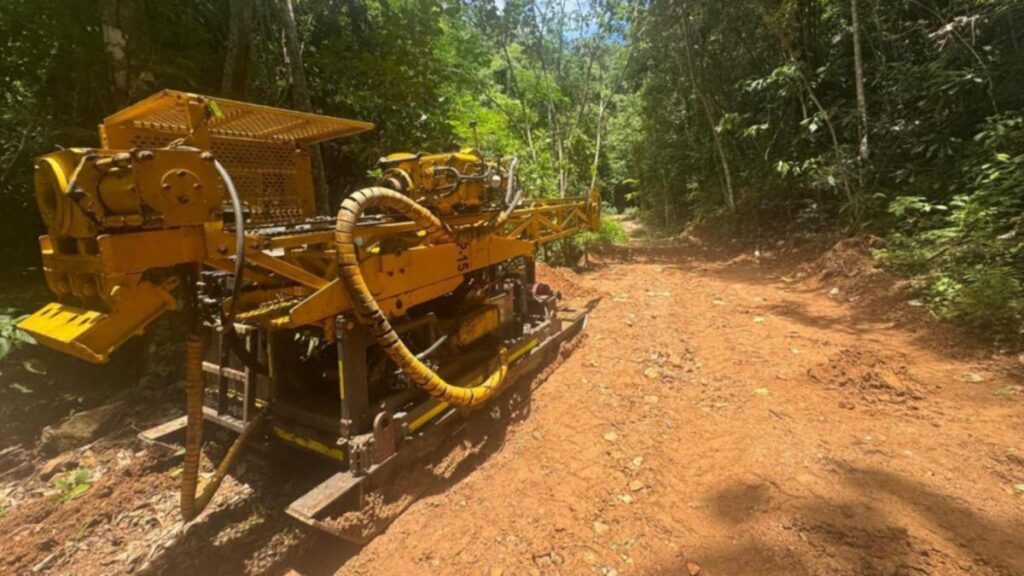Aguia Resources has fired up the diamond rigs at its high-grade Santa Barbara gold project in Colombia with a 25-hole, 2500-metre program designed to unlock a potentially huge discovery in the system’s rich mesothermal vein network.
The company will also pepper the existing stockwork to clear a path for expanded underground production and set the stage for a maiden JORC resource towards the end of the year.
Definition drilling will follow up on known mineralised zones at the Santa Barbara and Mariana workings, some already with shallow underground access. The company says the holes will typically be less than 100m deep and chase the Santa Barbara main vein and an associated structure known as Vein Two.
Deeper holes will then test the system’s downdip potential.
Aguia says confirmation of both grade and continuity at depth and along strike is the first item on its wish list, which will underpin its resource modelling and development plans.
The rig will then push deeper into discovery mode, shifting the focus to a broader exploration blitz across a 7-kilometre stretch of mapped surface veins.
The hunt is on to uncover repetitions and extensions of Santa Barbara’s main mineralised structures – and if the bit hits paydirt, Aguia could be staring down a geological jackpot.
The program is being guided by an in-house 3D structural model that has already hinted at a northerly trending domino-style fault system, which likely offsets and repeats the high-grade veins. The model has proven its worth, with artisanal workings turning up exactly where the geologists predicted and opening up a promising new southwest extension of the system.
Aguia’s Santa Barbara vein system appears to be shaping up as a potential standout in Colombia’s gold scene, showing striking similarities to big-name deposits, such as Segovia and Buriticá. All three are mesothermal systems known for high-grade gold and silver and Santa Barbara is already mirroring the other two in vein structure and gold-silver grade potential.
When Canadian-based Continental Gold released its resource at Buriticá in 2011, it unveiled 3.1 million ounces of gold and 11M ounces of silver from just 14 veins in the Yaraguá zone. In some instances, the veins were as narrow as 3 centimetres thick and often spaced less than 50m apart.
In comparison, Aguia says Santa Barbara’s footprint and density already match that scale. Like Aguia today, Continental ran a low-tonnage pilot plant during early exploration at Buriticá – a mirror-image strategy that could hint at what could be in store for Santa Barbara.
The company says drill pads have already been prepared and road access re-opened to the old timers’ mining sites. More rigs are set to mobilise when the results start flowing in.
If the results fall into place, management believes the Santa Barbara play has the potential to turn from a modest start-up operation into a high-margin, multi-million-ounce prize.
In March, the company released a geological assessment estimating a game-changing exploration target of 2M tonnes to 4Mt grading at 20-30 grams per tonne (g/t).
We have always been confident in developing a small but highly profitable underground gold mine which is happening now following several months of recommissioning. The real speculative appeal comes from the possibility that we could be sitting on a large high-grade gold resource. The next two months promises to be very exciting.
The past two months have been a busy time for Aguia at Santa Barbara, after it officially re-opened the mine with a first gold pour.
Trial mining by the previous owners showed head grades of up to 24g/t gold and Aguia is seeing comparable results from its current operations.
The underground workings have now been rehabilitated with a new ventilation system, upgraded electricals and an electrical locomotive.
The processing plant has also been refurbished. It is capable of treating 30 tonnes per day (tpd) of ore and on its way to a 50tpd uplift by July, with the addition of a new primary crusher.
Adding to the momentum, the company jumped a critical bureaucratic hurdle two weeks ago by locking in a full government nod to flog its gold domestically and internationally.
Although approval was expected, the timing was not. With signed paperwork in hand, Aguia has been able to get on with gold sales and capture prices currently trading near all-time highs at $5000 per ounce.
While Aguia has had its hands full reigniting the Santa Barbara gold project for early-stage cash flow, it has also been quietly laying the groundwork for a second revenue stream from organic phosphate production in southern Brazil.
The company recently locked in a 10-year lease on a fully operational Dagoberto Barcelos plant, just 100km from its Três Estradas deposit. With a modest monthly fee and a one-off payment of $1.36 million, Aguia is forecasting first production by July.
The plant, currently rated at 100,000 tonnes per annum, is in line for a few strategic upgrades that could triple its capacity and help the company close in on its original $22M annual EBITDA forecast.
Initial feed will come from the Pampafos deposit, but drilling is already underway at nearby Mato Grande and Passo Feio to cut haulage costs and beef up margins.
With a second plant on the radar and demand for organic fertilisers booming across Brazil, Aguia’s phosphate ambitions could soon match the excitement brewing at Santa Barbara.
If all goes to plan, the next few months could be critical for Aguia. The prospect of two operating revenue streams and an exciting exploration drilling program chasing a massive gold windfall during booming yellow metal prices is likely to have punters focused on the news flow.
It could also be the making of a junior explorer seeking to mature into a mid-tier miner.
Is your ASX-listed company doing something interesting? Contact: matt.birney@wanews.com.au

